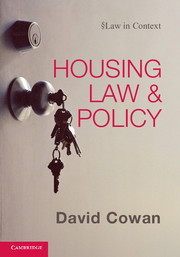Book contents
- Frontmatter
- Contents
- Preface
- List of abbreviations
- Table of legislation
- Table of international instruments
- Table of cases
- 1 Locating housing law and policy
- Part I Regulation of housing tenure
- 2 Regulating ownership
- 3 Regulating private renting
- 4 Regulating local authority housing
- 5 Regulating private registered providers
- Part II Access to housing
- Part III Rights and responsibilities
- Postscript
- Bibliography
- Index
3 - Regulating private renting
from Part I - Regulation of housing tenure
Published online by Cambridge University Press: 05 June 2012
- Frontmatter
- Contents
- Preface
- List of abbreviations
- Table of legislation
- Table of international instruments
- Table of cases
- 1 Locating housing law and policy
- Part I Regulation of housing tenure
- 2 Regulating ownership
- 3 Regulating private renting
- 4 Regulating local authority housing
- 5 Regulating private registered providers
- Part II Access to housing
- Part III Rights and responsibilities
- Postscript
- Bibliography
- Index
Summary
In the previous chapter, we looked at the ways in which the ownership market is regulated. In this chapter, our focus turns to the regulation of the PRS. We have already observed that private renting was in decline throughout the twentieth century, and it may well be that decline began in the late nineteenth century as a result of unaffordable rent rises (Ball 1983: 26, 205–6). Renting went into decline to the extent that, by the 1970s, as one author put it, renting was no longer considered ‘an appropriate activity for private enterprise’ (Berry 1974: 123). In this chapter, one central purpose is to explain the relation between the decline of the sector, its subsequent revival, and the relationship of both with changing regulatory structures and strategies.
In the first section, the focus is on what is known about the sector in terms both of the types of persons who become landlords and tenants, as well as the type (or, rather, quality) of property which becomes the subject of a private rental agreement. This is essential background material because it should define whether, how and why the sector is regulated. In the second section, we look to the regulating effect of law, drawing attention to the particular importance of the tenancy agreement on which statutory regulation bites. The interest here lies not just in the way in which the law constructs a tenancy agreement, as opposed to some other form, but also its regulating effects. We then go on to analyse briefly the history of general regulation, explaining the concept of security of tenure and the different ways in which the state has sought to deal with the amount landlords can charge for their tenants’ occupation of the property. In the third section, the focus turns to the Housing Act 2004. Beyond explanation of this complex Act, the panoply of regulatory techniques employed in that Act is interesting because it discloses no coherent regulatory strategy. In the final section, consideration is given to the different reform strategies for the sector. Few now believe that the sector operates as a perfect market, but there are different views about the way in which that market should be regulated in the future. This process of holistic review has stalled, however, under the Coalition government.
- Type
- Chapter
- Information
- Housing Law and Policy , pp. 51 - 75Publisher: Cambridge University PressPrint publication year: 2011



